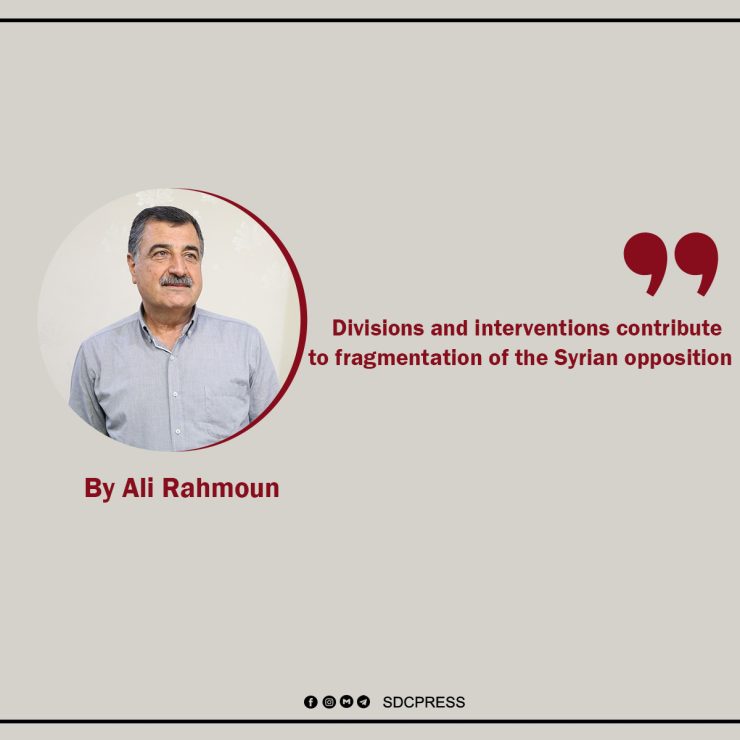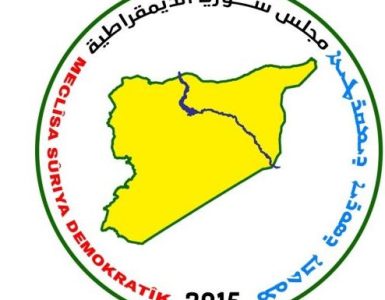By Ali Rahmoun
Deputy of the SDC’s Co-chairman
A comprehensive understanding of the current Syrian situation necessitates a retrospective analysis of its genesis. The popular uprising and revolution that unfolded in Syria were intrinsically linked to the broader Arab Spring and its reverberations. The initial sparks of this movement ignited on February 17, 2011, when a police officer insulted a citizen by beating him in al-Hariqa, Damascus. The protesters’ chant was “The Syrian people will not be humiliated”. This was followed by the outbreak of the events in Daraa, triggered by the writing of anti-government slogans on walls by protesters and the arrest of children, which led to widespread protests.
The first protest, organized by civil society activists, took place in al-Hamidiyeh Market, Damascus, on March 15, 2011, under the slogan “We stand for God, Syria and freedom”. Calls for revolution began to circulate on anonymous social media pages under various names that supported the uprising. On Friday, March 18, a call was made for a “Friday of Dignity” protest. The Syrian regime responded to these peaceful protests and popular movements in various Syrian cities with repression and gunfire. Therefore, the demands for freedom, dignity, and reform became calls for the overthrow of the regime.
At the outset of the uprising, political parties and powers did not play an effective role. They just followed the path of the popular movement. They had to lead and guide the weak and marginalized political powers. As a result, local coordination committees emerged, composed of politicians and young civilian activists. The goal of these committees was to unify efforts and monitor the on-the-ground movement. These committees were formed under the supervision and collaboration of some political figures and active political powers of the “Damascus Declaration for Democratic Change” Gathering formed in 2005. Notable signatories to the declaration included the National Democratic Gathering, Kurdish and Assyrian parties, the Communist Workers’ Party, the Muslim Brotherhood, and independent political figures. This declaration called for an elimination of the authoritarian rule, the establishment of a pluralistic and democratic regime, and a gradual, peaceful transition to democracy and equality for all citizens in a secular and sovereign Syria.
Also: Enhancing Syrian national identity is crucial amidst challenges
However, the declaration did not last more than a year due to disagreements over the secular nature of the state. The Muslim Brotherhood rescinded their endorsement of the declaration in 2006, followed by the Arab Socialist Union party. Subsequently the Labor Party and the Democratic Baath Party also rescinded their support of the declaration due to internal political and organizational disputes, especially after the arrest of the declaration’s proponents.
As the popular uprising gained momentum, some political figures called for the organization of protests and demonstrations. Prominent figures such as Michel Kilo, Burhan Ghalioun, Hussein al-Aoudat, Aref Dalilah, Abdul Aziz al-Khayr, Habib Issa, and Hazem Nahar were among those who issued these calls. They urged all opposition parties to reunite, and overcome their political and even personal differences, with the goal of developing a clear and unified vision for the unfolding events.
In response to these calls, the National Coordination Body was formed on June 30, 2011, comprising 15 political powers and independent figures. However, external entities soon played a direct role in causing the first major division within the Syrian opposition. At the end of 2011, under Qatari and Turkish patronage, the Syrian National Council was established as the political representative of the Syrian Revolution. 310 figures of the Council’s members were from the revolutionary movement. Also, the Council was dominated by Islamists and a bloc of liberal independents, along with remaining members of the Damascus Declaration, the Kurdish National Bloc, some figures from the Damascus Spring, and independent figures. Nevertheless, the Council was unable to represent all segments of the Syrian opposition. Consequently, it was expanded in Doha in October 2012 with the inclusion of additional political groups, leading to the formation of the “National Coalition for Change”.
It came to represent a spectrum of the Syrian opposition, having been formed to gain broad international recognition and secure support. Indeed, it gained international recognition and received substantial financial aid. However, it failed to achieve its objectives and was unable to represent the entire Syrian opposition. Therefore, the National Coordination Body and some influential political powers resigned from the Coalition. The Coalition failed to fulfill the aspirations of the Syrian people for many reasons.
The most notable reasons were as follows:
– The Coalition’s reliance on external military interventions.
– Its failure to adopt Geneva Statement 1 on June 30, 2012.
– The crucial role played by the international community regarding the events in Syria.
– The Coalition’s subordination to external agendas and its weak leadership.
– The dominance of Islamists on the Coalition.
Consequently, some powers began to resign. It eventually came to represent only itself, the Islamist movement, and Islamist figures under the name of independents
The continued presence of the Kurdish National Council and the Assyrian organization within it, contributed to be a part of the Negotiation Body. In fact, the Negotiation Body progressively assumed a vital political role. It emerged from the Riyadh Conference in December 2015. Therefore, it was tasked with overseeing the negotiation process with the Syrian regime within frameworks sponsored by the United Nations. The negotiations involved representatives from the Coalition, armed factions, the Coordination Body, the Moscow Platform, and the Cairo Platform.
Some Syrian, national and political powers, particularly Kurdish powers, the Syrian Democratic Council (SDC) and its affiliated parties were excluded due to a Turkish veto. In the same year, the idea of convening the Astana process under Russian auspices emerged by Randa Qassis. In April 2017, Qassis, a representative of the Astana platform, met with many figures working on the future Syrian constitution. The aim was to pave the way for holding the Conference of the Syrian National Dialogue in Sochi, Russia. The Sochi resolutions regarding the constitutional committee, known as the Astana process, played a significant role in delaying the implementation of UN Security Council Resolution 2254 and undermining its content.
So, the intervening countries in the Syrian issue were able to implement their agendas. Once again, the Syrian powers remained divided and fragmented. They did not create a shared vision or unified goals for building a nation that guarantees the freedom and dignity of its people.
Also: Empowering Syrian women addresses current challenges and shapes the future
The Syrian regime contributed to fragmenting and dividing political forces, offering false promises to them, and its persistent obstruction to achieve Syrians’ demands. It was facilitated by the presence of powerful allies of the Syrian regime such as Russia and Iran. As a result, there was a lack of political elites capable of addressing the Syrian crisis and leading the Syrian movement to safety. Instead of taking action to resolve the crisis and address the deteriorating situation, these powers continue to justify their incompetence and failure.
Syria is in danger of having an uncertain future due to divisions and reliance on external entities. The country may face further tyranny, wars, and even occupations. The Syrian regime has not agreed on any proposed solution to the catastrophic crisis that affected us as Syrians on all levels. It will never agree because it is a tyrannical, incompetent, and incapable regime. It has been obstructive towards any solutions presented to it.
Given this situation and the fragility of the opposition, we as Syrians must work diligently to achieve common understandings and a national consensus on unified goals. We must work to create a new vision for the future of our homeland. This will be achieved through an agreement on our commonalities as a basis for holding a meeting. This meeting should involve political figures capable of realizing the aspirations of Syrians for freedom, dignity, and equal citizenship.
This catastrophic situation necessitates a well-organized and cohesive Syrian party led by wise, patriotic, and political leadership. This leadership should be characterized by national values, flexibility, and acceptance of others’ opinions, without any exclusion or marginalization. The Syrian situation requires a genuine and effective political power to make the Syrian issue a top international priority. The purpose is to achieve a political solution that meets the aspirations of the Syrian people for freedom and dignity.
The SDC has strived to engage in the national dialogue with all political powers and parties. It believes that the only way which will save Syrians from the crisis is a peaceful political solution based on international resolutions, primarily UN Security Council Resolution 2254. Through the intra-Syrian dialogue among the national opposition, which the SDC adopts as its approach, the consensus on shared visions and objectives will be achieved. Consequently, that will lead to holding a conference that includes all national and democratic powers and independent political figures to reach a political solution that will achieve the political transition to a united, democratic, and decentralized Syria. The country that will ensure equal citizenship for all Syrians. Therefore, in accordance with the decisions of the SDC’s Fourth Conference, we continue to engage in national dialogue and work diligently with other democratic powers and figures. The aim is to reach consensus on visions and objectives in accordance with Stockholm Process as a crucial step towards a better future.




